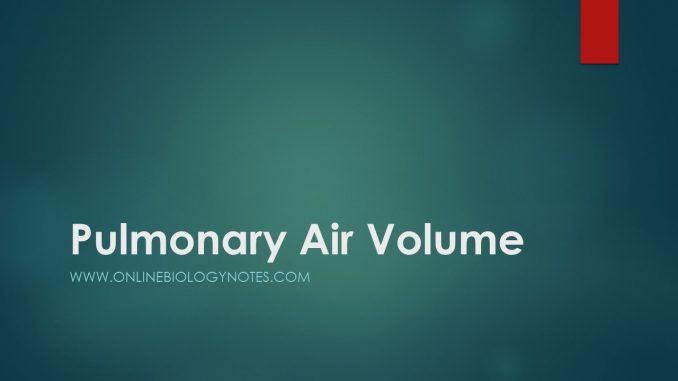
Pulmonary air volume and capacities
- In normal quiet breathing there are about 15 complete respiratory cycles per minute. The amount of air exchanged during breathing is measured by an instrument called Spirometer or Resprometer.
- The amount of air present in lung under different condition is known as pulmonary air volume and the capacities of lungs to hold air varies according to conditions.
- some of the pulmonary air volume are:
1. Tidal volume (TV):
- This is the amount of air passing into and out of the lungs during each cycle of breathing.
- It is about 500 mL at rest.
2. Inspiratory reserve volume (IRV):
- This is the volume of air that can be inhaled into the lungs during normal inspiration.
- It is about 1500 ml.
3. Expiratory reserve volume (ERV):
- This is the total volume of air which can be expelled from the lungs forcefully during normal expiration.
- It is about 1100ml.
4. Inspiratory capacity (IC):
- This is the amount of air that can be inspired with maximum effort.
- It consists of the tidal volume (500 ml) plus the inspiratory reserve volume. IC = TV + IRV
- It is about 2000ml
5. Functional residual capacity (FRC):
- This is the amount of air remaining in the lungs after normal expiration.
- It is equal to ERV+ RV= 1100+1200= 2300ml.ue the pr ocess of respiration. this means that exchange of gases is not interrupted between breath.
- The functional residual volume also prevents collapse of the alveoli on expiration.
6. Residual volume (RV):
- This is the volume of air remaining in the lungs after forceful expiration.
- It is about 1200ml.
7. Vital capacity (VC):
- This is the maximum volume of air which can be expired after forceful inspiration in single breath.
- VC= TV+IRV+ERV= 500+1500+1100
- VC of athletes is more than normal person.
8. Total lung capacity (TLC):
- This is the maximum amount of air the lungs can hold after forceful inspiration.
- It is normally about 5000-6000 ml in adult.
- TLC=VC + RV.
9. Dead space:
- The lungs and the air passages are never empty.
- Out of 500ml of air inspired during normal respiration, 350ml are exchanged across the walls of the alveolar ducts.
- About 150ml of air always remains in the respiratory passage called as dead space.
